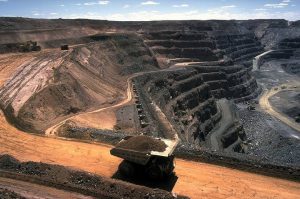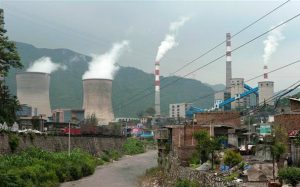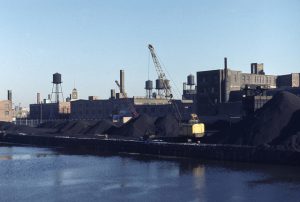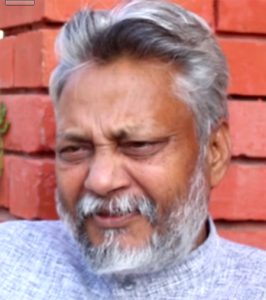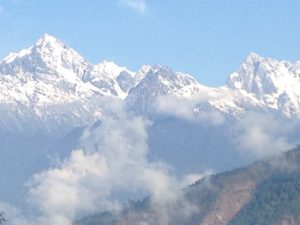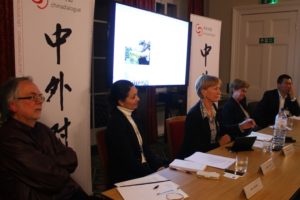Australian farmer John Hamparsum squats down, scoops up a handful of earth and holds it out for me to sniff.
“You can smell fertility, smell living organisms. It’s like really good compost,” he says. We’re standing in a field of ripening sorghum on John’s property on the Liverpool Plains in north-western New South Wales The black soil whose bouquet he is inviting me to savour is some of the richest in Australia.
Sorghum from these plains is in high demand in China. It’s used to produce a popular traditional white liquor called baijiu. But another Australian commodity that lies beneath the black soil plains is dividing local residents, threatening a political upset at the state election in March, and causing big headaches for the federal government.
Guardian Australia understands the agriculture minister, Barnaby Joyce, and environment minister, Greg Hunt, will both make a flying visit to the plains within days. Shenhua Watermark Coal, a subsidiary of the Chinese state-owned Shenhua Group, is waiting for final approval from Hunt for a US$1.2bn open-cut coalmine on the edge of the plains, a little more than three kilometres from Hamparsum’s property.
“This is about dining versus mining,” Hamparsum says. “We grow everything from durum wheat for premium pasta manufacturing to the corn in corn chips.”
The stakes are high, and Shenhua, the world’s largest coal producer, is champing at the bit.
This week, Shenhua Australia chairman, Liu Xiang, turned up the pressure on Hunt, telling Guardian Australia that, after eight years, “Shenhua has spent US$700m and has little tangible progress to show for this investment in NSW.”
If Hunt gives the green light, Shenhua will begin work on the first of three pits covering 3,500 hectares, from which it will export nearly 270m tonnes of coal over the next 30 years. Most of it will be burned in power stations in China.
Local farmers, community groups and the NSW Farmers Federation are mounting a last-ditch offensive to stop the mine. And if that means inviting journalists to eat dirt, so be it.
“You’ve really got to taste the soil to know how good it is,” Hamparsum says, offering me a morsel.
The Sydney radio presenter Alan Jones, who has given fierce backing to the campaign, repeated that invitation on the ABC’s Q&A program last week, telling the audience “this is soil you could eat”.
Jones is just one of a chorus of voices who have joined farmers in opposing the mine – including AustralianSuper and Reserve Bank board member Heather Ridout – and state and federal National party politicians are starting to feel the heat.
China pays big for land
Last week the NSW deputy premier, Troy Grant, and the state member for Tamworth, Kevin Anderson, flew up for a meeting at the home of Andrew Pursehouse, another prominent Liverpool Plains farmer.
“They probably thought they had the answers before they were here, but I think there were a lot of question marks in their minds when they left,” says Pursehouse, speaking to me on the veranda of his house. He likes to joke that he shares three boundaries with the Chinese government; land belonging to his neighbours was acquired by Shenhua at up to 10 times the market price.
Some of those questions will be about the mine’s impact on the NSW state election. Anderson holds the seat on a margin of 6.8% but local sources say National party polling shows Anderson is vulnerable and could lose to independent Peter Draper.
Draper is not a farmer; he makes his living as a driving instructor. He has held Tamworth twice before, and says he has never experienced such a groundswell of support, which he attributes to his opposition to the mine.
Approval
Draper is scathing about the state government’s Planning Assessment Commission (Pac), which gave its final approval for the mine in late January. The Pac found that protection of the black soil plains was “critically important”, but that the mine’s location on the hills above the plains “should not jeopardise” agricultural production.
“The [PAC] process is designed to rubber stamp mines so that the government can get money in,” says Draper, after a rally outside Shenhua’s headquarters in Gunnedah to mark Chinese New Year.
“I just can’t believe that we have farmers now that are having to support the Greens,” he says. “We know we should be voting for the National party, but how can you vote for a National party that won’t support protecting the Liverpool Plains?”
The message must be getting through to Joyce, the federal deputy leader of the Nationals. He told local ABC radio shortly after the Pac decision was announced that he had “never agreed” with coal mining on the Breeza plain, south of Gunnedah, and that the Shenhua mine was “anathema”.
Water supply
Last week Joyce wrote to his cabinet colleague Hunt asking if “urgent consideration” could be given to stopping the mine in light of community concerns. Joyce is also pressing the minister to reconsider the Namoi catchment water study conducted by Schlumberger Water Services in 2012.
Shenhua has consistently argued that the Watermark mine would not affect the plains’ alluvial aquifers, which feed the Namoi catchment, because the three open-cut pits will be on ridges above the plains.
But those ridges are only 50m high, and opponents of the mine argue that none of the water modelling done so far, including an independent study commissioned by the Pac, addresses the connection between the ridges and the plains.
“We need to understand the connectivity between the plains, the Great Artesian Basin and the Gunnedah Basin aquifers before we can determine the impact of such large-scale coal mining on the Namoi catchment,” says Hugh Price of the Namoi Community Network, “but we still don’t have enough data to do that.”
Shenhua’s project director in Gunnedah, Paul Jackson, maintains “the science has been peer-reviewed to death”.
Weak rationale?
Jackson says that if Hunt gives the mine the go-ahead, construction will begin early in 2016. The first wagon of coal will head down the rail line to Newcastle in December 2017, and from there to China.
“That means 425 new jobs at start-up, ramping up to 600 when we hit full production,” he says.
Some have questioned the economic rationale for the mine, citing falling world coal prices, a supply glut and a commitment by the Chinese president, Xi Jinping, to reduce emissions and his country’s dependence on coal.
Rory Simington, the principal Asia Pacific coal analyst with Wood Mackenzie, says that at today’s prices, “very few coal projects in Australia make a lot of sense”.
Despite this, he expects coal consumption in China to increase at 3% a year over the next 10 years, and coal imports to increase 6%.
Key fuel
Simington says the Watermark project is a resource of high-energy, high-quality thermal coal, which makes it highly attractive for Beijing in the longer term.
“Despite the leadership’s move to reduce coal’s share in power generation, the absolute level of coal consumption will increase, and coal will still be a key fuel,” he says.
If Simington is right, there would be a strong incentive for Shenhua to extend its mining operations out into the vast reserves of coal that lie under the Liverpool Plains. Many farmers believe that is Shenhua’s long-term plan.
Hamparsum says Shenhua is the largest underground miner of coal in the world. “The big concern is that they’ll get this approval and then they’ll ask for a modification to go underground because that’s where the good coal is, very deep and there’s lots of it,” he says.
But Jackson maintains that an extension of the mine is “never going to get a guernsey”. He says Shenhua’s exploration licence rules out long-wall mining under the black soil plains.
This is a shortened version of a story published in the UK’s Guardian website.
Research for this story was funded by an Australian Research Council discovery grant: The Coal Rush and Beyond: Investigating coal reliance, environmental change, and contested futures in Australia, India and Germany. Additional research by Rebecca Pearse and Sally Alden.

